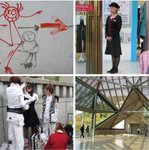
Udgivet 23/12/2010
Theme editor: Anemone Platz
Anemone Platz
Introduction
In an innovative collaboration between the University of Copenhagen, University of Aarhus and several Danish art institutions two weekend seminars were held in spring of 2009 under the title “Visualizing Asian Modernity: The Global Rise of Contemporary Japanese and East Asian Visual Arts”. The present special issue gathers a selection of some of the important topics discussed at the seminars.
Gunhild Borggreen
Asian art on display: Questions of representation in the ethnographic turn
Taking the theoretical clues from Hal Foster and Miwon Kwon, the text discusses theoretical aspects of the relationship between art and society in the so-called ”ethnographic turn”. The discussion is related to examples of art projects mentioned by other contributions in this issue, and concludes with a call for critical reflections on part of Western museums in their attempt to ”represent” art from Asian countries.
Anne Wedell-Wedellsborg
Contextualizing Cai Guo-Qiang
The spectacular large-scale installations by transnational Chinese artist, Cai Guo-Qiang, transmit a special ambiguity that creates different allegorical resonances in the context of a global art world and in a Chinese cultural context. This article discusses the method and impact of Cai ´s manipulative use of Chineseness in his work.
Minna Valjakka
Performance art at Tian’anmen
Conducting performance art at Tian’anmen Square in Beijing is highly controversial and usually not allowed by officials. Despite constrictions, some Chinese and Hongkongnese artists have managed to conduct performances that reflect the role of Tian’anmen as a local memory site for both national and private identity. The understanding of these artworks and how they resonate with this specific space as sitedependent art, depend primarily on Mao’s triple-presence in the Square (in visual, metaphorical and physical terms), and on the four major elements of performance art: the usage of artist’s body/self, the site of the performance.
Krestina Skirl
Popular Culture and Gender Issues in Miwa Yanagi's Art Practice - a critical approach towards images of identity and femininity currently circulating in Japanese popular culture
This paper explores the crossover between art and popular culture in the art practice of the contemporary Japanese artist Miwa Yanagi, arguing that her art works seem to take a critical approach towards images of identity - and above all images of femininity - currently circulating in Japanese popular culture. At the same time, this paper also demonstrates that Miwa Yanagi’s works appear to engage in issues of identity and gender from a more overall and philosophical perspective, in a way which moves beyond an entirely Japanese context.
Reiko Tomii
Akasegawa Genpei as a Populist Avant-Garde: An Alternative View to Japanese Popular Culture
When we discuss “Japanese popular culture” and visual-art practices informed by it, it is almost obligatory to examine manga, anime, games, and such. However, postwar Japan boasts a long and diverse tradition of popular culture, not all of which has been known outside the country. A notable example is Akasegawa Genpei, an artist who emerged as a young practitioner of Anti-Art (Han-geijutsu) in the 1960s and since made a remarkable transition to the realm of popular culture. In his work, marked by his vanguard spirit and conceptualist strategies, art, society, and popular culture intersect in often unforeseen and strange ways.
Yoshitaka M?ri
New Art and Culture in the Age of Freeter in Japan - On young part time workers and the ideology of creativity
The article discusses recent developments in the Japanese art scene with special attention to the changing relation between art and society in post-Lehman shock Japan. The main actors in this contemporary art scene are artists belonging to the so-called freeter generation born in the 1970es, the special characteristics of their art work often based on the development of a kyara, as well as its politicization and creativity.
Adrian Favell
Tokyo to LA Story - How Southern California became the Gateway for a Japanese Global Pop Art Phenomenon
An analysis of the demographic and geographic conditions that have enabled Los Angeles (LA) to become a gateway for imports of Japanese contemporary cultures in the West, illustrated with the case of Japanese contemporary art, and the international success stories of Takashi Murakami and Yoshitomo Nara.